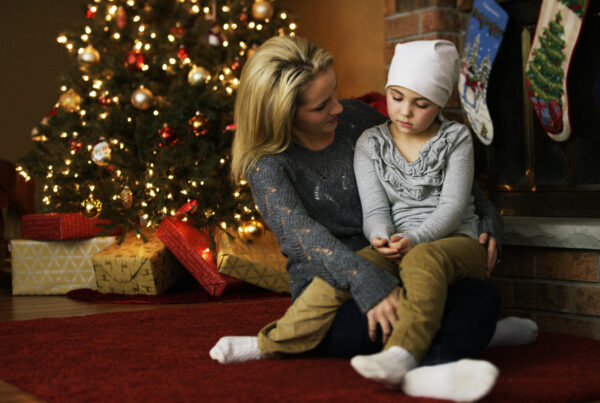by Crystal Williams, Ed.M.
Home visits are a primary form of service delivery in early intervention (EI). During home visits a professional or team of professionals come into the home to provide services, such as speech, physical, occupational, or developmental therapy. In the past, home visits were largely provider-centered. It was not unusual for professionals to walk into a home carrying a bag filled with toys and materials to be used to address specific goals for the child. This method is more provider-centered than family-centered, with the professional bringing materials to the session based on their priorities for and beliefs about the child (as opposed to the family’s priorities).
The concept of family-centered practices began to develop around the middle of the 20th century but rose to the forefront of EI practices in the 1980s and beyond. [1] These practices emphasize the empowerment of caregivers to help their children reach developmental milestones. Recent findings emphasize the importance of caregiver participation in therapy. [2] In this process, the EI provider works with the family to determine goals and ways to embed intervention into their daily routines. This leads to greater generalization of skills which allows children to use those specific skills within many contexts. [3]
One way to increase caregiver participation during EI home visits involves an approach called bagless intervention. This growing method of delivering services in EI uses family routines, activities, and materials that are natural to the child to promote skill development. This method aligns with EI principles [4] and recommended practices [5] and is described in the article What about MY Toys: A Bagless Approach in Early Intervention. [6] A bagless approach includes the family in selecting routines and materials already in the home to address the goals on the Individualized Family Services Plan (IFSP). For example, a family may want their toddler to request foods at mealtimes. The provider might work with the family at mealtime to give the child choices between foods and request more by using the sign for “more.” The goals for the child should be based on the family’s priorities. Families may be more engaged in intervention when they know that their priorities and concerns are being addressed.
For a printable resource to give to families see this blog post where you will find activity cards to give to caregivers and families to support at-home skill practice using common household items.
When caregivers play an active role in creating functional goals for their children, outcomes improve [7]. Functional goals are those that encourage children to participate more effectively in their natural environments, such as home, child care, or community settings. Much of a child’s day is spent with caregivers, thus promoting caregiver competence during home visits is vital. Shifting from traditional, provider-centered therapy to bagless intervention is one way to improve caregiver competence. When a toy bag is used in a home visit, caregivers may not have the opportunity to practice the skills addressed in the visit because the therapist often takes the toys with them at the end of the session. [2] Bagless therapists are able to teach families how to use every day routines, such as a bath or mealtime, and every day materials, such as a cup or bowl, to increase their child’s skills.
Children learn new skills through their interactions with their caregivers [4]. Therapists should strive to convey to parents that it is not a specific toy or two that are the change agents but instead it is the interaction between the child and the caregiver which has a greater effect on children’s skill development. This interaction can occur when using a variety of materials or no materials at all. In bagless intervention materials should come from the family’s home (i.e., sorting socks, playing with measuring cups or plastic containers in the bathtub). Professionals can help caregivers consider ways to use and adapt the toys and items they already have to promote skill development during adult:child interactions.
Bagless intervention is also flexible and individualized. This is especially important for military families who have unique circumstances and needs. A bagless approach provides therapists with the flexibility to meet a variety of military family needs, such as separation, reunification, and PTSD. A therapist who uses this approach can support military families by suggesting ways to include the military parent in the child’s intervention based on their unique circumstances. For example, as bagless intervention sessions are not dependent upon a set of materials brought into the home, but instead what is already available, the familiarity of the items may bring a sense of security to a military member experiencing PTSD which may increase their self-confidence. Additionally, when a deployed family member is able to call home, other family members can have the materials or supplies needed to engage the deployed member in an activity with their child to help promote development.
Finally, bagless intervention is adaptable. Every home visit should be planned according to a family’s goals for their child. In order to remain effective, professionals must be knowledgeable about a family’s routines, priorities, and needs. When a toy bag is not present on which the provider can rely, they must instead adapt intervention sessions to align with the routines and materials in the home while still addressing skills that are important to the family. For example, if a family’s goal for their child is to use 2 word combinations to communicate their wants, a therapist must help the family think of materials in the home and aspects of their daily routines that support this goal. When caregivers are encouraged to embed goals into everyday routines they are able to support their child’s development with increased ease and confidence.
1. Dunst C., Espe-Sherwindt M. (2016). Family-centered practices in early childhood intervention. In B. Reichow, B. Boyd, E., Barton, & S. L. Odom (Eds.) Handbook of early childhood special education (pp. 37-55). Springer.
2. Crawford, M. J., & Weber, B. (2014). Early intervention every day!: Embedding activities in daily routines for young children and their families. Baltimore, MD: Brookes Publishing.
3. Johnson, J., Rahn, N. L., & Bricker, D. (2004). An activity-based approach to early intervention(4th ed.). Baltimore, MD: Brookes Publishing.
4. Workgroup on Principles and Practices in Natural Environments, OSEP TA Community of Practice: Part C Settings. (2008, March). Seven key principles: Looks like / doesn’t look like. Retrieved from http://ectacenter.org/~pdfs/topics/families/Principles_LooksLike_DoesntLookLike3_11_08.pdf
5. Pletcher, L., & Younggren, N. (2013). The early intervention workbook: Essential practices for quality services. Baltimore, MD: Brookes Publishing.
6. Williams, C. & Ostrosky, M. (2018). What about MY TOYS? Common Questions about a using a bagless approach in early intervention. Manuscript submitted for publication to Young Exceptional Children.
7. McWilliam, R. A. (2010). Routines-based early intervention: Supporting young children and their families. Baltimore, Md: Brookes Publishing.
Image used with permission, R. DiPietro-Wells













